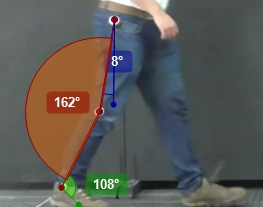Gait analysis of a person with a hands-free crutch using the Kinovea software

Published 2022-05-19
Keywords
- gait analysis,
- biomechanics,
- rehabilitation engineering,
- hand-free crutch,
- orthosis
- physiotherapy,
- lesions below the knee,
- Kinovea ...More
How to Cite
Copyright (c) 2022 Revista UIS Ingenierías

This work is licensed under a Creative Commons Attribution-NoDerivatives 4.0 International License.
Abstract
The human gait is a series of movements of the lower extremities and trunk to move the body forward and can be affected using prostheses and orthoses. A hands-free crutch was built as an alternative to conventional crutches, which presents problems in some parts of its design and requires a gait analysis, which is carried out using the Kinovea software. The current study compared three situations: normal gait, using the orthosis, and accompanying the device with a Canadian cane. It is noted that there are abnormalities when using the orthosis compared to normal walking which is slightly corrected with the auxiliary support of the cane. It is concluded that the orthosis is deficient in its walking cycle, so it is proposed to make structural changes. Developing this hands-free crutch will improve the quality of life for patients with lower limb injuries.
Downloads
References
- V. Paús, F. Torrengo, “Incidencia de lesiones en jugadores de fútbol profesional,” Rev. AATD, 2003.
- W. J. Crosbie, A. C. Nicol, “Biomechanical comparison of two paraplegic gait patterns,” Clin. Biomech., vol. 5, no. 2, pp. 97-107, 1990, doi: https://doi.org/10.1016/0268-0033(90)90044-7
- F. A. Quijano López, “Diseño y construcción de una órtesis de apoyo para personas con lesiones en los miembros inferiores debajo de rodilla”, trabajo de grado, Universidad Industrial de Santander, 2016.
- K. D. Martin, A. M. Unangst, J. Huh, J. Chisholm, “Patient Preference and Physical Demand for Hands-Free Single Crutch vs Standard Axillary Crutches in Foot and Ankle Patients,” Foot Ankle Int., vol. 40, no. 10, pp. 1203-1208, 2019, doi: https://doi.org/10.1177/1071100719862743
- K. Mannan, C. Belcham, H. Beaumont, J. Ritchi, D. Singh, “The hands free crutch. mobility and functional assessment.,” Orthop. Proc., vol. 90-B, no. SUPP_II, p. 228, 2018.
- C. A. Oatis, Kinesiology: The mechanics and pathomechanics of human movement. Lippincott Williams & Wilkins, 2009, pp. 892-913.
- M. Nordin, V. H. Frankel, Basic biomechanics of the musculoskeletal system. Lippincott Williams & Wilkins, 2012, pp. 426-443.
- A. I. Agudelo Mendoza, T. Briñez Santamaria, V. Guarín Urrego, J. P. Ruiz Restrepo, M. C. Zapata García, “Marcha: descripción, métodos, herramientas de evaluación y parámetros de normalidad reportados en la literatura,” CES Mov. y Salud, vol. 1, no. 1, pp. 29-43, 2013.
- N. Amirah et al., “Measuring Ankle Angle and Analysis of Walking Gait using Kinovea,” in IMEDITEC, pp. 247-250, 2017.
- D. Capecci, S. H. Kim, K. B. Reed, I. Handzic, “Crutch tip for swing-through crutch walking control based on a kinetic shape,” 2015 IEEE International Conference on Rehabilitation Robotics (ICORR), 2015, doi: https://doi.org/10.1109/ICORR.2015.7281268
- C. Harrington, S. Joines, “Assessing user experience with crutch use: A review of literature,” Proc. Hum. Factors Ergon. Soc., pp. 1658-1662, 2011, doi: https://doi.org/10.1177/1071181311551345
- R. Rambani, M. S. Shahid, S. Goyal, “The use of a hands-free crutch in patients with musculoskeletal injuries: Randomized control trial,” Int. J. Rehabil. Res., vol. 30, no. 4, pp. 357-359, 2007, doi: https://doi.org/10.1097/mrr.0b013e3282f1fecf
- B. M. González Martínez, “Diseño de un mecanismo de ayuda técnica para la marcha a manos libres para lesiones temporales en un miembro inferior en personas de 21 a 50 años para desplazamiento horizontal”, trabajo de grado, Universidad Católica Santo Toribio de Mogrovejo, 2018.
- U. Lugrís, J. Carlín, A. Luaces, J. Cuadrado, “Gait analysis system for spinal cord-injured subjects assisted by active orthoses and crutches,” Proc. Inst. Mech. Eng. Part K J. Multi-body Dyn., vol. 227, no. 4, pp. 363-374, 2013, doi: https://doi.org/10.1177/1464419313494935
- C. Schwabe, M. Kraus, TK. Wasserman, “Hands-Free Wearable Crutch,” trabajo de grado, Santa Clara University, 2018.
